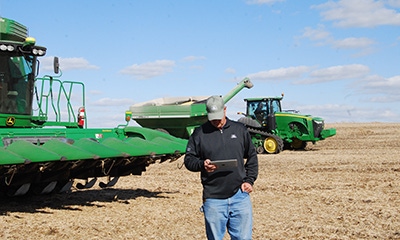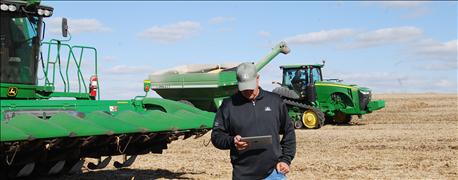October 28, 2015

Despite how well you budget or how efficiently you manage your farm business, there may be periods in which cash flow is negative. No one knows for sure when they will occur, or how long they will last. That's why every farm should have a financial contingency plan to provide for unexpected shortfalls in cash flow.
Consider these 10 ideas as potential opportunities to improve your operation's liquidity when projected cash inflows fall short of projected cash outflows. They are listed in order of practicality and convenience.
1. Utilize cash surpluses you've built up from previous years. This may involve tapping into savings accounts or liquidating financial assets.

WHAT'S YOUR PLAN?: Low crop prices and high costs affect everyone. No matter how well you budget or how efficiently you run your farm business, there may be periods when cash flow will be negative. Every farmer should have a plan to provide for unexpected cash flow shortfalls.
2. Seek a credit reserve or unused borrowing capacity for both current expenses and longer term investments.
3. Sell stored crops, which are part of the farm's working capital. You can still use futures, options and/or basis contracts to benefit from potential higher futures prices should they occur in the spring or summer months.
4. Refinance current liabilities by using equity in longer term assets, such as land or machinery. Likewise, try to lengthen the repayment period on term loans. Balloon payments can also be used to reduce debt servicing in the short run. This would allow for smaller payments in the short term and a large payment at the end of the borrowing period, when cash flow has (hopefully) improved.
5. Hold off on capital asset purchases. Refurbish existing equipment instead of replacing it. Consider leasing assets instead of owning them; machinery lease payments are often lower than loan payments
6. Take advantage of the Farm Service Agency (FSA) guaranteed loan program to reduce credit risk with your primary lender and improve repayment terms and interest rates. FSA also offers low-interest marketing loans on stored grain for up to nine months.
7. Increase nonfarm or off-farm income. Family members can provide part-time or full-time employment that might bring in added income and reduce healthcare and insurance expenses. Alternatively, use your farm assets and labor to perform services for others. Examples include moving snow, hauling grain, installing tile, repairing machinery and remodeling buildings.
8. Cut nonfarm expenses, especially family living costs. Postpone investments in vehicles and non-essential assets. Utilize consumer credit or educational loans, if necessary.
9. Cancel or renegotiate cash farm leases if high cash rents make it unlikely that you will at least cover variable costs. Propose a flexible cash rent or crop-share arrangement. Cash outlays can be reduced even further by converting a farm lease to a custom farming agreement.
10. Sell off less productive assets to raise cash. If liquidating assets produces a large taxable income, check to see if income averaging with prior tax years can reduce your tax liability.
~~~PAGE_BREAK_HERE~~~
Low crop prices and high costs affect everyone. These 10 ideas are not substitutes for good risk management and marketing strategies. In some cases, actions that are not profitable in the long run may have to be taken in order to cover cash flow obligations in the short run. But, depending on the severity of the farm's financial condition, any of them can be applied as a means to continue operating until profitability returns.
For several more ideas on stretching your farming operation's cash flow dollars, see comments from William Edwards, ISU Extension economist (retired) in file C3-58, October 2015, on the ISU Ag Decision Maker website. He also offers these observations:
* Financial stress can lead to increased stress in other areas. During unprofitable times in agriculture, check in with friends and neighbors. If you or someone you know is struggling, encourage them to seek professional help, possibly from a medical professional, clergy person or counselor. Assistance is also available anytime through the Iowa Concern Hotline at 800-447-1985 or Iowa Concern Hotline.
* ISU Extension and Outreach offers a free and confidential program called Farm Financial Planning. It consists of one-on-one counseling with trained farm business consultants who provide help developing accurate financial statements, budgeting alternative actions, and contacting other Extension programs or outside services that may be useful. More information is available at extension.iastate.edu/farmanalysis/. For a list of Farm Financial Planning associates go to extension.iastate.edu/farmanalysis/associatelist.htm.
Editor's note: Steve Johnson is the ISU Extension farm management specialist for central Iowa. He can be contacted at [email protected].
For farm management information and analysis visit ISU's Ag Decision Maker site extension.iastate.edu/agdm; ISU Extension farm management specialist Steve Johnson's site is at extension.iastate.edu/polk/farm-management.
You May Also Like




